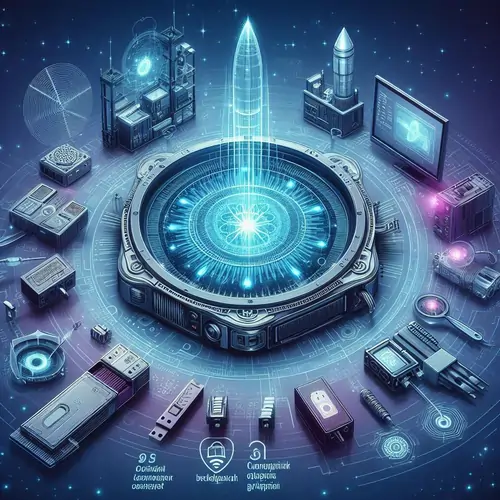- 1. OpenWRT Routers: Customizing the Network at Its Core
- 2. QUIC and Media Streaming: A Protocol Built for the Future
- DNS Over QUIC
- Media Over QUIC
- 3. Breaking Records with Fiber Optics: 301 Tbps Transmission
- 4. Alice and Bob: The Cryptographic Duo That Never Ages
- 5. Starlink Satellites with Lasers: Building the Internet in Space
- Inter-Satellite Links via Laser
- 6. AMS-IX: A Pillar of Internet Infrastructure Turns 30
- Final Thoughts: Why These Trends Matter for Networking Students
We don’t just assist students in solving complex assignments—we help them stay updated with the latest real-world developments that shape the future of networking. Whether you’re working on a university lab, developing your thesis, or diving into an advanced computer networks course, staying current with evolving protocols and technologies is crucial. As part of our commitment to quality computer network assignment help, we ensure students understand not just the “how,” but also the “why” behind modern networking systems.
In this blog, our expert team explores key advancements making headlines in the field of computer networking. From the increasing popularity of OpenWRT routers for hands-on experimentation to the evolving QUIC protocol now supporting media services, we highlight what matters most. We also examine the recent 301 Tbps fiber optic speed record, the continued relevance of Alice and Bob in cryptography education, Starlink's groundbreaking laser-based inter-satellite links, and the 30-year history of AMS-IX. These developments offer deep insights for any networking student aiming to excel.
1. OpenWRT Routers: Customizing the Network at Its Core
For students keen on learning more than textbook definitions, OpenWRT is a great starting point. It’s not just another firmware—it’s a full-fledged Linux distribution specifically designed for routers. That means it turns a basic router into a fully configurable networking device with the features and flexibility of a Linux-based OS.

Many home routers provided by ISPs already use some variant of OpenWRT (especially those based on xDSL or cable modems). The project supports everything from small consumer routers to powerful enterprise devices.
Recently, the OpenWRT leadership announced an exciting development: they are working on a reference router that will be commercially available. This means that students, hobbyists, and network researchers will soon have a go-to, standardized platform for experimentation, learning, and development.
If you're planning to explore concepts like VLANs, packet filtering, bandwidth shaping, or even IPv6 configurations, OpenWRT gives you a real-world environment to work with—far beyond any classroom simulation.
2. QUIC and Media Streaming: A Protocol Built for the Future
The QUIC protocol has quickly become a pillar of modern networking. Originally designed to support faster and more secure web services, it’s now the default for many cloud providers and content delivery networks.
But QUIC isn’t limited to browsing websites. Recent developments show that it’s also becoming essential for media delivery and DNS resolution.
DNS Over QUIC
Modern Android devices use DNS over HTTP/3, which is built on top of QUIC. Apple uses it too—particularly for services like iCloud Private Relay, which enhances user privacy by encrypting DNS and web traffic.
Media Over QUIC
More recently, the IETF has created a Media over QUIC working group. This initiative is exploring how the QUIC protocol can be optimized to handle streaming media, ensuring lower latency and improved reliability.
What makes QUIC ideal for media?
- It supports multiplexing without the head-of-line blocking seen in TCP.
- It uses UDP under the hood, offering more flexibility.
- It has built-in TLS encryption, ensuring secure data transfer.
This is an exciting area for students interested in streaming services, protocol design, and next-gen communication systems. Understanding how QUIC evolves from a browser-centric protocol to one capable of carrying audio/video can prepare students for careers in content delivery and edge computing.
3. Breaking Records with Fiber Optics: 301 Tbps Transmission
A common student question is: “How much data can a single fiber optic cable carry?” The answer just got an upgrade.
Recently, NICT set a new record by transmitting 301 terabits per second (Tbps) through a commercial optical fiber.
To put that into perspective:
- That’s enough to stream millions of HD videos simultaneously.
- It exceeds the previous record and sets a new benchmark for long-distance high-capacity communication.
The breakthrough was achieved without exotic lab-only fibers—it was done using standard commercial fiber, which makes the technology scalable and practical.
For students learning about optical networking, this milestone reinforces the importance of advanced modulation techniques, wavelength-division multiplexing (WDM), and efficient signal amplification.
Such advancements make fiber the backbone of the internet—and also remind us that physical infrastructure still plays a crucial role, even in a world full of wireless and satellite links.
4. Alice and Bob: The Cryptographic Duo That Never Ages
No conversation about computer networks, especially network security, is complete without mentioning Alice and Bob.
These two characters are legendary in the cryptography community. They were first introduced in a landmark paper that outlined the foundations of modern encryption. Ever since, they've been the stars of numerous protocol explanations.
Why are Alice and Bob important?
- Alice is usually the sender.
- Bob is the intended receiver.
- Eve (the eavesdropper) and Mallory (the malicious attacker) join in later scenarios.
Their simplified representation helps explain everything from RSA encryption and Diffie-Hellman key exchange to zero-knowledge proofs.
Understanding how Alice and Bob work through challenges like authentication, key exchange, and man-in-the-middle attacks is more than academic—it’s foundational for any student pursuing cybersecurity or privacy engineering.
These characters humanize complex protocols and help students visualize abstract concepts in a digestible format.
5. Starlink Satellites with Lasers: Building the Internet in Space
The first generation of Starlink satellites acted more like repeaters—they received a signal from a home satellite dish and forwarded it to the nearest ground station connected to the internet. While effective, this model relied heavily on the presence and proximity of ground infrastructure.
But now, Starlink is evolving.
Inter-Satellite Links via Laser
Recent versions of Starlink satellites come equipped with laser-based communication systems. These allow satellites to communicate directly with each other, forming a mesh network in space—a huge leap from the previous one-hop designs.
This brings several key benefits:
- Lower latency for users far from a ground station
- Improved redundancy by routing around failures
- Better coverage in remote regions like oceans, deserts, and polar zones
In practice, this means some users are just two or three satellite hops away from an internet uplink. Although technical details about these laser links are scarce, presentations and informal sources suggest they use optical interconnects with ultra-low latency.
For students interested in space-based networking, satellite communications, or low-Earth orbit (LEO) constellations, this is a fascinating development. It’s the beginning of a decentralized orbital network—a concept that could redefine global connectivity.
6. AMS-IX: A Pillar of Internet Infrastructure Turns 30
The Amsterdam Internet Exchange (AMS-IX) is one of the most influential and busiest Internet Exchange Points (IXPs) in the world. It recently celebrated its 30th anniversary, a huge milestone in the history of internet architecture.
What does AMS-IX do?
- It allows multiple ISPs and networks to interconnect directly rather than routing traffic through third parties.
- This improves latency, speed, and reliability.
- It reduces transit costs by eliminating intermediaries.
AMS-IX is a textbook example of peering infrastructure, which every networking student should be familiar with. Peering determines how content reaches users, how services scale, and how efficiently global data moves.
Their 30-year timeline offers insights into:
- How IXPs scaled from modest beginnings
- The adoption of 10G, 100G, and now 400G interconnects
- The critical role IXPs play in internet neutrality and openness
Understanding AMS-IX helps students grasp the economic and engineering backbone of the internet—something that’s often missed in protocol-heavy syllabi.
Final Thoughts: Why These Trends Matter for Networking Students
The world of computer networking is evolving rapidly—and not just in academic papers. From the firmware running your home router to satellites beaming data across space, the innovations shaping connectivity today are tangible, real, and exciting.
At computernetworkassignmenthelp.com, we believe students deserve to see the real-world relevance behind their assignments. Whether you're working on a simulation of a secure communication protocol, configuring a router for QoS, or writing a paper on future internet architectures, staying informed on these trends will elevate both your understanding and your academic performance.
